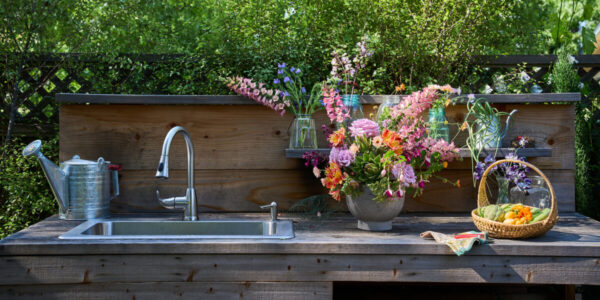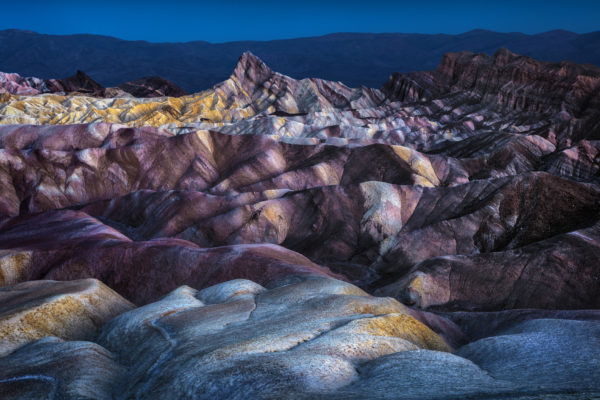
Chasing Down Death Valley’s Most Dramatic, Gorgeous Landscapes
In fall, the fabled desert park is at its most hauntingly beautiful. Hike, explore, and experience a world unlike any other

At Zabriskie Point in Death Valley National Park, my husband, Jim, and I are watching the world change colors. At this canyon overlook in the southeastern California desert, the striated rocks stretch in sculptural towers and eroded gullies off to the eastern horizon.
With every passing moment, they shift shades, emerging from predawn violet and slate to glowing pinks and golds as the sun peeks over the ridge to the east.
We hold our breath and try to absorb each moment in the cool early-morning air. It is a fleeting, phenomenally beautiful show. Jim and I have learned that here in the desert, timing is everything. And we have come at just the right time. We’re on what a friend of mine calls a “babymoon” ― a last excursion before we have our first child. And this spot, the harshest, driest place in North America, far from cell phone range and everything else, offers nature raw and unveiled. I can’t think of a better place for appreciating life anew.
Vast and surreal, dry and hot and wild, Death Valley stretches far enough to let your mind run to thoughts of deep time. Sandstone canyons etched over eons and slowly expanding Badwater Basin ― created as two mountain ranges separate themselves from each other ― make geology a visible and active presence here.
Death Valley is the West at its most extreme. An isolated 150-mile-long finger of wilderness, it’s the hottest spot in North America; a record summertime temperature of 134° has been bested only once (in the Sahara Desert). Yet the place holds lots of evolutionarily innovative spirits: Desert pupfish, for instance, survive in water five times saltier than the ocean. A certain kind of mouse spends its life roaming Mesquite Flat’s dunes without ever needing a drink of water.
A SECRET INLAND OCEAN
Death Valley is big. The park consists of more than 3.3 million acres of mountain and desert ― so large that even though we have five full days here, we have to make some choices on what to see. Because it’s our first visit, we opt for the classic, brand-name attractions: Badwater Basin, Zabriskie Point, Artists Palette, The Inn at The Oasis at Death Valley.
Even getting to Death Valley involves some effort. In terms of time, the journey isn’t long: a three-hour drive from Las Vegas, five from Los Angeles. But for desert novices like us, it tests our understanding of the world. As Jim and I wind along State 178, we keep thinking we’ve reached the park, only to zip over another pass. We climb over Argus Range; I look out expectantly at rocky Panamint Valley, but we’re not quite there. We drive on, Jim whistling to his road-trip iPod mix; Guy Lombardo croons, “Enjoy yourself, it’s later than you think.”
We finally descend into Death Valley, arriving at Stovepipe Wells late in the morning. We stop here to get a drink and a sun hat for me (since I’ve foolishly forgotten mine), then read the warning signs about hiking without water or leaving your dog in the car during the day. The message: This is unforgiving country – and we can see that all around. The dirt is bleached and cracked; the air quiet with the stillness of midday.
But we’re here at a great time. November temperatures are much milder than summer extremes, with warm but not hot days and cool nights. And fall is a quiet time to visit too: Today it seems to us that the park is practically empty. We have millions of acres to ourselves.
Beyond Stovepipe Wells, the dunes at Mesquite Flat undulate off to the horizon. It’s as if, after all of this driving, we’ve arrived at a secret inland ocean. We have to explore. But the heavy, rippling sand sucks at our feet, and at five months pregnant, I’m not in my best hiking shape. I take it slow, focusing on the details. The footsteps of lizards have left tiny, delicate patterns across the dunes. A wren rustles the leaves of a mesquite bush. My footsteps squeak the sand.
Chief naturalist Terry Baldino, who has worked in Death Valley for 11 years, tells me later that this is what he loves about the park – there is so much to explore, on a small and large scale. “A lot of other parks give you a list and say, ‘Here are all the trails, stay on the trails.’ We don’t really have trails. The beauty of this park is that you can go up a canyon that thousands of others have gone up, but you do it on your own,” he says. “It’s the sense of adventure you get from this vastness.”
DESCENT TO BADWATER
Badwater Basin is the salty heart of the park. It’s the lowest point in North America, the mineral remains of a former lake. Gray Telescope Peak, a far point on the western ridges, shimmers in the heat. Jim and I follow a path about a quarter-mile into the flats; salt crunches under our feet. We are two small vertical smudges on a white horizontal moonscape.
We stop to chat with another couple on our way back. They are from the Netherlands, making a six-week tour of the parks in the American West. “Your wilderness is so beautiful,” the woman says to us. “We want to spend longer at each place. We are sad that we have to leave here this afternoon.”
At last, we pull into The Inn at The Oasis at Death Valley, a travertine-and-adobe structure with an oasis of date palms, tamarisk trees, and a natural spring. Built in 1927 by the Pacific Coast Borax Company, the place has the glamour of Old Hollywood. We walk through the garden to the pool, warmed by natural springs, and take a dip. As we lie in chairs just out of the sun, a woman brings me lemonade and a cocktail for Jim. This is luxury.
Stone arches at the pool’s edge frame the sun setting behind the Panamint Range to the west. The evening emerges, intensely blue. And the desert is transformed; the air softens, birdcalls echo back and forth, and a bat swoops over the water. The stars are crisp and bright.We’re energized. On our walk to the dining room, for a meal of fried prickly pear cactus, strip steak, and empanadas, we hear something rustling just beyond our vision: When we get to our room, we see a coyote jogging off into the desert.
FINDING THE FUTURE AT ZABRISKIE POINTMany people have told me that sunrise is the most magical moment in the desert, so, although it’s against my nature, we set our alarms well before dawn and head out toward Zabriskie Point. We pull into a lot and are surprised that many vehicles are already here. We hike up a short hill, and once over the crest see two dozen or more people filling the overlook; photography students have set up cameras and stands in a row along one edge; one couple huddles together, paper coffee cups in their hands; three young hikers have descended the steep ridge to the east to avoid all the other photographers.
Funny, here we are in the largest park in the continental United States, in the slow season, before dawn, and yet we’ve found ourselves in a crowd of people trying to freeze a certain moment. But then the sky lightens, and the canyon glows from the still-hidden sun. It doesn’t really matter who else is around us, the show is so captivating.
Eventually the sun itself emerges from behind the ridge, and the canyon settles into tones of gold and cream and dusky brown. The photographers begin to pack up their equipment and head back down the trail. One hour has transformed the place; I guess that’s the idea. Time does that here, in a daily, fleeting way and on a grand, irrevocable scale. No wonder so many dreamers have been drawn to this valley; no wonder photographers try so hard to capture its moments of transition.
Jim and I take a last long glance at the golden canyon, recording it in our mind’s eye since we don’t have cameras, and head down the trail ourselves. Then I stop short and take a breath. Jim asks if I’m okay and I nod; it’s just the future kicking me in the ribs.
